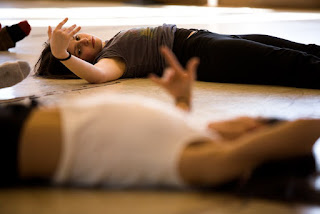by Paul Gordon Emerson
Music. Movement. Meaning.
Most of the time choreographers come to the studio with their music picked. The score is "to tape" meaning its already finished and the composer, musicians, producers and everyone associated with its making are long-since done. Its rare that those artists even know that their music is being used. Of course sometimes those composers have been dead for a few hundred years, so the idea of collaboration is, well, moot (barring the intervention of some psychic somewhere with a special link to Mozart and 18th century Germany).
Making dances, regardless of the score, is remarkably challenging. Where music is concerned it means choosing to follow or to ignore the score. Regardless, it means acquiring a deep understanding of the music -- far more than simply understanding what meter its in. But where there is collaboration between composer, musician, choreographer and dancer the challenges, and the opportunities, grow phenomenally.
Today, with the enormous and exceptional Studio 405 as the canvas, a composer, Sis McKay, and a choreographer, Isabel Croxatto, sat down to try and understand their respective arts, to talk possibilities and to see if they could speak their respective languages together. One speaks in sound. The other in silence. Yet they need each other to realize a dream. And, remarkably, that began to happen.
Isabel is an exceptionally vibrant, visceral mover. She understands the elemental in ways most of us can never access. And she understands sound. Not words. Sound. Her physical exploration of what it is to be something profoundly physical, to understand the sound trees make in interacting with the wind, the sound humans make in breathing through many moods, from ecstasy to agony, is astonishing. And it gave Sis something to grab onto. Sis, too, understands the elemental, and they started to understand those elements from their mutual disciplines and find common-ground.
Making music for dance, as opposed to making dances to music, is a deeply collaborative process. It requires letting ego go to make a unified vision. Its hard. But its also one of the most rewarding things that any dance-maker can be a part of. We've done this many times, and I do it every chance I get, but to watch the process unfold from the outside was inspiring. What comes next I have no idea. They may make something together for April 12, or they may not. But the discovery process, the finding of common ground and common voice across two arts is remarkably fun to watch happen.

















